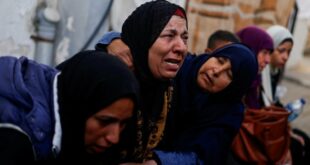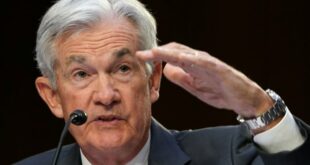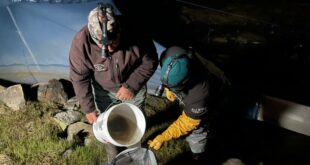Environmental issues a key focus as King and Prince of Wales make trips abroad

Hello, royal watchers. This is your regular dose of royal news and analysis. Reading this online? Sign up here to get this delivered to your inbox.
On both sides of the Atlantic Ocean this past week, senior members of the Royal Family stepped onto the world stage — and put a prime concern they share front and centre.
In what appeared to be carefully co-ordinated timing, King Charles made his first state visit to France as monarch, landing in Paris the day after his eldest son and heir, Prince William, wrapped up a two-day trip to New York City.
"There has been speculation that King Charles III's reign was going to be more focused on the United Kingdom than on the world stage, because some of these longer tours weren't taking place," Toronto-based royal author and historian Carolyn Harris said in an interview.
"But now we are seeing King Charles III and the Prince of Wales stepping onto the world stage and that is likely to continue in the months to come."
Charles's three-day visit, which wrapped up on Friday, was postponed from March, when there were mass protests over pension reform in France.
This week's trip is only the latest in a long line of royal visits to the country across the English Channel. Charles made 34 visits there as Prince of Wales.

This time, as monarch, there was also some high-level diplomacy at play.
"There's an important diplomatic element to this visit, as the United Kingdom is renegotiating its relationship with the rest of Europe in the aftermath of Brexit," said Harris.
As much as the trip could be looking to the future, there were also parallels to the past, and a new monarch setting out on the world stage after the death of his long-reigning mother.
"There's an interesting echo with the situation at the end of Victoria's reign," Judith Rowbotham, a social and cultural scholar and visiting research professor at the University of Plymouth in southwestern England, said via email.
Victoria's successor, King Edward VII, made a visit to France early in his reign that was "a diplomatic triumph," Rowbotham said, and, among other things, saw Edward speaking in fluent French and "coming up with the soft diplomacy that enabled the Entente Cordiale."
That agreement in 1904 was a friendly understanding between Britain and France that aimed to settle territorial disputes, and it was on Charles's mind as he delivered the first speech by a British monarch to representatives of both houses of the French parliament.

"Together, our potential is limitless," Charles said in French.
"That's why we must cherish and take care of our entente cordiale. For future generations, so it becomes an entente for sustainability to tackle more efficiently the global urgency in terms of climate and diversity."
Rowbotham was struck by how Charles's visit showed "clever management" of both continuity and change.
"Like Edward VII, [Charles] spoke fluent French to his audiences. Like him, he emphasized the long-standing ties and promoted an Entente Cordiale. But Charles's vision was of an entente of cordiality over environmental issues."
Environmental issues were also at the forefront of William's visit to New York, whether he was donning hip waders to step into the East River and get a closer look at an oyster reef restoration project, speaking at an environmental summit or announcing finalists for his Earthshot prize.
"The presence of Prince William wading into the river in rubber overalls meant that the New York Times was giving this project a great deal of coverage," said Harris.
"Wherever Prince William goes, the press follows. And so he has this real opportunity to raise the profile of these environmental initiatives."

Harris saw William's trip as an example of the "shorter, more targeted royal tours focusing on particular issues" that are more common these days, unlike previous generations of the Royal Family undertaking longer overseas visits that focused on a variety of issues.
Rather than a state visit like his father's, William's "was more of a 'private' excursion in that it was not something formally organized by the government," said Rowbotham.
"But that doesn't mean that there are no diplomatic dimensions here, for the monarchy in the longer term and for William, the person who happens also to be Prince of Wales and the next monarch in succession to his father."
Rowbotham also saw William's trip as a "cleverly and carefully managed visit that was timed to whet the appetite for more royal news in the shape of the subsequent state visit" Charles made to France.
As much as both trips had serious focuses, there were lighter moments, too. Charles recounted that La Vie en Rose — the signature song of French singing great Édith Piaf — is one of his favourites. Prince William had a chance encounter with several women from Nova Scotia who were, according to media reports, visiting the Big Apple on a joint birthday celebration.
"He said, 'I won't ask how old you are,'" said Barb Patterson, of Halifax. "I said, 'I'm 60.' He said, 'Let's say 50.'"
A piece of a 19th-century prince returns home

Our colleague Lauren Sproule in CBC's London bureau had this report this week:
A lock of hair from the head of a 19th-century Ethiopian prince was handed over to representatives of his home country in a private ceremony in London Thursday evening.
The celebration was marked with champagne and canapés as the Ethiopian ambassador to the United Kingdom received the hair of Crown Prince Alemayehu, who is buried at Windsor Castle.
"It's a very important part of our history … life was difficult for him," said ambassador Teferi Melesse Desta.
Other culturally and religiously significant items that were taken from Ethiopia 155 years ago, including a shield and three cups, were also returned Thursday night. The ambassador spoke of them "returning to their rightful place … where they can continue to inspire and educate for generations to come."
The handover is one of the latest instalments in a reckoning of heritage taking place in former imperial centres all over the world.
"The returning of this lock of hair is a signal that restitutions can be made in a spirit of goodwill and respect, and we hope that they will inspire other restitutions to take place in the near future," said Tahir Shah, one of the founders of the Scheherazade Foundation, the not-for-profit organization facilitating the returns.
Pleas for treasures of cultural and religious significance to be returned to their land of origin have been answered this year in Vatican City and in Edinburgh, where a totem pole was recently sent back to the members of the Nisga'a Nation in northwestern British Columbia.
"In the past, the answer was always 'no,'" said Dan Hicks, a British archaeologist and author of The Brutish Museums.
"In recent years, we've seen a real sea change in how that has been addressed … the idea of returning items on a case-by-case basis, when they're asked for to be returned."
Some of the items repatriated Thursday were taken during the Siege of Maqdala in 1868, when British troops descended on the mountaintop kingdom in Abyssinia, now Ethiopia.

Representatives from the British Museum were part of the contingent that travelled to Maqdala, allegedly for the planned plunder of cultural heritage, according to an article published in the Cambridge University Press.
But it was more than just gold taken by the soldiers in the closing days of the dry season in Abyssinia. Among the cargo was a seven-year-old boy named Alemayehu.
A supposed descendant of King Solomon, Alemayehu was the only legitimate son of Emperor Tewodros II, who imprisoned several European missionaries and diplomats in an attempt to goad the British government into a military alliance.
This action was met with force in the form of 13,000 British and Indian soldiers. Emperor Tewodros decided he would rather die than fall captive to the invading army, so he took his own life as the battle encircled the walls of his fortress.
Once the spears fell and the guns went quiet, Alemayehu and his widowed mother were taken in by the troops and prepared for the journey to England.
While his mother died en route, Alemayehu eventually made his way to English shores, where he was front-page news and became a recurring character in the diaries of Queen Victoria.
"Heard that the Emperor Theodore's poor little boy, whom we had been expecting since yesterday, had arrived.… Little Alamayan is a very pretty, slight graceful boy of seven with beautiful eyes," Victoria wrote on July 16, 1868.
"Capt. Speedy, who has brought him, says the poor boy will never leave him for a moment, and always sleeps near him."
Capt. Tristram Speedy was an officer in the British Army and the prince's guardian before he was sent to boarding school.
Speedy and Alemayehu kept in touch sporadically, and the lock of hair handed over on Thursday was found by a descendant of Speedy's among family heirlooms.
The young prince's life came to an end in northern England shortly before his 19th birthday. At Queen Victoria's request, he was interred in the catacombs of St. George's Chapel at Windsor Castle.

Artifacts from Ethiopia have found their way as far afield as the Royal Ontario Museum in Toronto. It houses a communion plate, tapestry and drinking cup that can trace their "provenance to Ethiopia," a representative for the ROM said via email.
The representative said there are no active restitution dialogues taking place concerning the objects, which are in storage.
Appeals for repatriation have extended beyond objects to human remains.
In 2007, Ethiopian president Wolde-Giorgis Girma wrote a letter to Queen Elizabeth requesting the repatriation of Alemayehu's body.
The request for Alemayehu's repatriation was reportedly rejected by Buckingham Palace, which cited "considerable practical difficulties" around his removal.
This sentiment was echoed by the palace earlier this year when the BBC reached out for a comment and was told: "It is very unlikely that it would be possible to exhume the remains without disturbing the resting place of a substantial number of others in the vicinity."

Critics have called this reasoning into question, because human remains have been moved in the past. King Charles III's paternal grandmother was buried in St. George's Chapel in 1969 and her remains transferred to Jerusalem 19 years later.
Hicks believes King Charles is being badly advised to hold onto "old arguments."
"These issues over returns are not about sending back or trying to purge the past … they're about how institutions respond to reasonable requests in the present, which are about human dignity."
Last year, the remains of 18 Indigenous people were returned to Australia by two British museums, including the Pitt Rivers Museum in Oxford, England, where Hicks serves as curator.
"The sky hasn't fallen in on museums," said Hicks. "In many ways, this is making museums more relevant for their audiences … making them spaces for living, not for dying."
Royal rapport on the air
The setting was formal. The chatter was not.
With a room at Windsor Castle as the backdrop, Prince William; Catherine, Princess of Wales; and Princess Anne were guests on a recent episode of Anne's son-in-law's podcast, offering a relatively rare chance to see and hear members of the Royal Family speaking more informally with one another.
Mike Tindall and his co-hosts brought their The Good, The Bad and The Rugby podcast inside Windsor Castle, with conversation ranging from the value the royals see in sports to how competitive William and Catherine are with one another. (Very competitive, apparently, although that has long been known and mentioned in passing in media reports.)
The "relaxed rapport" among the royals caught the attention of Harris.
"Often popular culture portrayals of royal life emphasize formality, the palaces, the etiquette, the degree to which members of the Royal Family sometimes communicate through their staff," she said.
"But that podcast episode … really emphasized the degree to which various members of the Royal Family have this shared interest in sports, a shared sense of humour."

Harris also thought it was interesting the degree to which Tindall appears to get along very well with his mother-in-law and his wife's cousins.
"There's been so much discussion and debate about the challenges for people who marry into the Royal Family to become part of this environment if they didn't grow up in a royal household," said Harris.
"It's clear that Mike Tindall has become a royal insider and gets along very well with the Royal Family."
As much as the podcast showed the royals chatting and laughing informally with one another, there weren't many in-depth revelations about life behind palace walls.
Rowbotham said the episode was "designed to appeal to the age group who are supposedly less interested and engaged with the monarchy as an institution."
"It told the public very little, if anything, that was new about these senior royals," she said.
"It just packaged and presented it in a new medium" and "underlines that the Royal Family understands the need to be flexible in how they are reported and accessed by the public, especially the U.K. public."
Royally quotable
"I think if we remark on how pessimistic and doom-and-gloom everything is, even though there is a healthy dose of that needed … it doesn't provoke the reaction from us humans that we would like."
— Prince William, warning against pessimism in discussions tackling climate change, during his trip to New York.

Royal reads
-
Senior British government officials spoke to Buckingham Palace at the height of the pandemic to express their concern about then-prime minister Boris Johnson's conduct in office, the BBC has been told.
-
British television channels agreed to let Buckingham Palace censor television coverage of King Charles's coronation, according to the former boss of Sky News. [The Guardian]
-
A cyclist captured the moment he bumped into King Charles while riding on the Balmoral estate. [ITV]
-
A red sweater worn by Diana, Princess of Wales, which has a pattern showing one black sheep among many white ones, sold for $1.14 million US at auction. [ITV]
-
At the Invictus Games in Germany, Prince Harry and Meghan, Duchess of Sussex, attended a reception thrown by the Canadian delegation to promote the 2025 edition of the sporting competition he founded for wounded, injured and sick soldiers and veterans. Vancouver will host those games, which will feature winter sports for the first time. [Daily Mail]
Sign up here to have The Royal Fascinator newsletter land in your inbox every other Friday.
I'm always happy to hear from you. Send your questions, ideas, comments, feedback and notes to royalfascinator@cbc.ca. Problems with the newsletter? Please let me know about any typos, errors or glitches.
- Get the news you need without restrictions. Download our free CBC News App.

Add some “good” to your morning and evening.
A variety of newsletters you'll love, delivered straight to you.
*****
Credit belongs to : www.cbc.ca
 MaharlikaNews | Canada Leading Online Filipino Newspaper Portal The No. 1 most engaged information website for Filipino – Canadian in Canada. MaharlikaNews.com received almost a quarter a million visitors in 2020.
MaharlikaNews | Canada Leading Online Filipino Newspaper Portal The No. 1 most engaged information website for Filipino – Canadian in Canada. MaharlikaNews.com received almost a quarter a million visitors in 2020.








